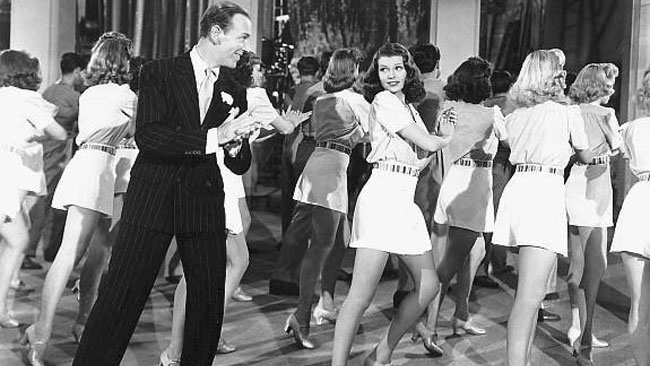Film Review: An Insouciant Double Bill — Rita Hayworth meets Fred Astaire
Womanizing Astaire grasps that Rita is the loveliest catch of all, and a keeper, in this musical treat.

Fred Astaire and Rita Hayworth dancing in “You Were Never Lovelier.” Screening at the Brattle Theatre on August 6.
By Gerald Peary
The Brattle Theater’s Rita Hayworth retrospective goes all-musical August 6 with an insouciant double bill of Rita meets Fred Astaire, he slumming at Columbia Pictures after his elegant RKO triumphs with Ginger Rogers.
In You’ll Never Get Rich (1941), Astaire plays Bob Curtis, a snappy Cagney-like choreographer charged with making dancers out of cute bodies in very brief shorts — all hoofing on cue in a shameless lift from Busby Berkley musicals. As a favor to his giddy boss, Courtland (Robert Benchley), Curtis becomes romantically entangled with the classiest girl in the chorus line, shapely Sheila Winthrup (Hayworth). This Sheila is no gold digger on the make but a gal of wholesome character, waiting for a deserved break.
You’ll Never Get Rich starts off quite wonderfully with Astaire tap dancing on cue against a female chorus line. He is then displayed with Hayworth in a rousing show of boogie-woogie footwork. Hayworth keeps up splendidly. Juxtaposed with the musical numbers is a very funny screwball plot detailing Benchley’s wacky attempts to hide his obsessive intrigues from his sly, almost omniscient wife, played with jaded boredom by tall, proud Frieda Inescort.
Unfortunately, the central section of the movie descends to the lowest level of farce, the “service comedy,” that unfortunate genre companion to World War Two. Hayworth is forgotten while Astaire is drafted into a zany army filled with lame comedians headed by doubletalk artist Cliff Nazarro, who performs his one thin joke a dozen times. Astaire is burdened by director Sidney Lanfield with comic bits so trying they would embarrass even The Three Stooges.
At last Hayworth is brought back into the story via a variety show on the base. Because this film was made at stingy Columbia, the “variety” is held to one number, “The Wedding Cakewalk,” with dancing war brides and hoofing soldier boys, and Astaire marrying Hayworth in the middle of the production number. In homage to Busby Berkeley again, the camera pulls back at one point to show three levels of dancers kicking their heels on a giant white army tank. Atop are our two stars, the bride and groom on a militarized wedding cake. It’s a happy ending for a slap happy film, with Hayworth faring excellently opposite a post-Ginger Astaire.

A scene featuring Fred Astaire and Rita Hayworth in “You’ll Never Get Rich,” screening at the Brattle Theatre on August 6.
For Columbia President Harry Cohn, Astaire took up an offer for a second coupling with Hayworth for You Were Never Lovelier (1942). Hayworth was elated. “I guess the only jewels of my life were the pictures I made with Fred Astaire,” she told the New York Times in 1970. “Fred asked for me. He knew I was a dancer, he knew what all those dumb-dumbs at Columbia didn’t know.” Hayworth plays Maria Acuna, daughter of a hotel magnate (Adolphe Mejou), “the most opinionated man in South America.” She has inherited her father’s arrogant self-confidence and his obdurate misanthropy. She is sexual beauty without sexual feeling, Artemis without a hint of Aphrodite. And she is positively frightening to the feeble suitors who fall at her feet.
Enter Robert Davis (Astaire), indigent dancer and philanderer, down on his luck in Buenos Aires. Mr. Acuna can’t stand him around, neither dancing in the hotels nor chasing his daughter. In an outrageously Freudian maneuver, father tries to perk up his daughter’s libido for other men than Davis by becoming himself her imaginary lover.
You Were Never Lovelier surrounds the Oedipal plot with flavorful melodies from Jerome Kern. Astaire dances a remarkable solo showoff number around Acuna’s office, which dazzles the film audience but not the intractable papa. Fred and Rita join for a lush, romantic dance in the cool evening, very close in choreography to Astaire-Rogers’s sublime “Night and Day” in The Gay Divorcee. They also come back for a feisty jitterbug around a jukebox. Hayworth here is her inimitable Life cover girl self, wearing a tiny pleated skirt and white bobby sox in a perfect rendition of adolescent soda shop sensuality. And boy gets girl. Womanizing Astaire grasps that Rita is the loveliest catch of all, and a keeper, in this musical treat.
Gerald Peary is a retired film studies professor at Suffolk University, Boston, curator of the Boston University Cinematheque, and the general editor of the “Conversations with Filmmakers” series from the University Press of Mississippi. A critic for the late Boston Phoenix, he is the author of nine books on cinema, writer-director of the documentaries For the Love of Movies: the Story of American Film Criticism and Archie’s Betty, and a featured actor in the 2013 independent narrative Computer Chess.
Tagged: Brattle Theatre, Columbia Pictures, Fred Astaire, musical, Rita Hayworth, You Were Never Lovelier
